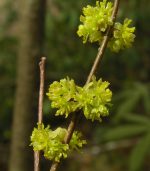 This deciudous flowering shrub is native to eastern North America from Maine to northern Florida and west to Ontaraio, Kansas, and Texas where it grows in moist areas of woods espically where there is exposed limestone. It is a member of the laural family, Lauraceae, that also includes avocado, cinnamon, and sassafras. Plants grow 6-12′ tall and wide, and have aromatic, brown to gray-brown stems sprinkled with circular lenticels, and thick light green leaves that are 3-6″ long, oblong-obvate and turn bright yellow in the fall. The leaves provide food for the larvae of the spicebush swallowtail butterfly. Clusters of tiny, greenish-yellow male and female flowers appear in separate plants in early spring before the leaves emerge. The flowers are aromatic, lack petals and the male flowers are larger and showier than the female ones. Female flowers give way to bright red berries in the fall that are 1/2″ long and attractive to birds. The plants are easy to grow and are a good choice for woodland, native plant, wildlife, bird, and butterfly gardens. The genus name, Lindera, honors Johann Linder (1676-1723) Swedish botanist and physician. The specific epithet, benzoin, is from an Arabic vernacular word meaning aromatic gum.
This deciudous flowering shrub is native to eastern North America from Maine to northern Florida and west to Ontaraio, Kansas, and Texas where it grows in moist areas of woods espically where there is exposed limestone. It is a member of the laural family, Lauraceae, that also includes avocado, cinnamon, and sassafras. Plants grow 6-12′ tall and wide, and have aromatic, brown to gray-brown stems sprinkled with circular lenticels, and thick light green leaves that are 3-6″ long, oblong-obvate and turn bright yellow in the fall. The leaves provide food for the larvae of the spicebush swallowtail butterfly. Clusters of tiny, greenish-yellow male and female flowers appear in separate plants in early spring before the leaves emerge. The flowers are aromatic, lack petals and the male flowers are larger and showier than the female ones. Female flowers give way to bright red berries in the fall that are 1/2″ long and attractive to birds. The plants are easy to grow and are a good choice for woodland, native plant, wildlife, bird, and butterfly gardens. The genus name, Lindera, honors Johann Linder (1676-1723) Swedish botanist and physician. The specific epithet, benzoin, is from an Arabic vernacular word meaning aromatic gum.
Type: Flowering deciduous shrub
Outstanding Feature: Fall coloration
Form: Rounded
Growth Rate: Slow
Bloom: Clusters of greenish-yellow male and female flowers in spring
Size: 6-12′ x 6-12′ W
Light: Full sun to part shade
Soil: Average, medium moist, well-drained
Hardiness: Zones 4-9
Care: Low maintenance
Pests and Diseases: Laural wilt
Propagation: Fresh seed
Outstanding Selections:
‘Rubra’
‘Xanthocarpa’
Photo Credit: Wikipedia